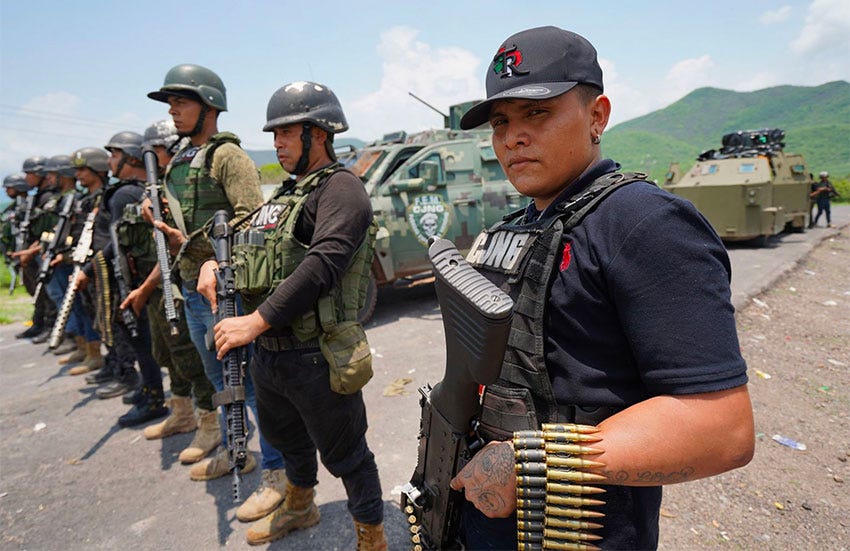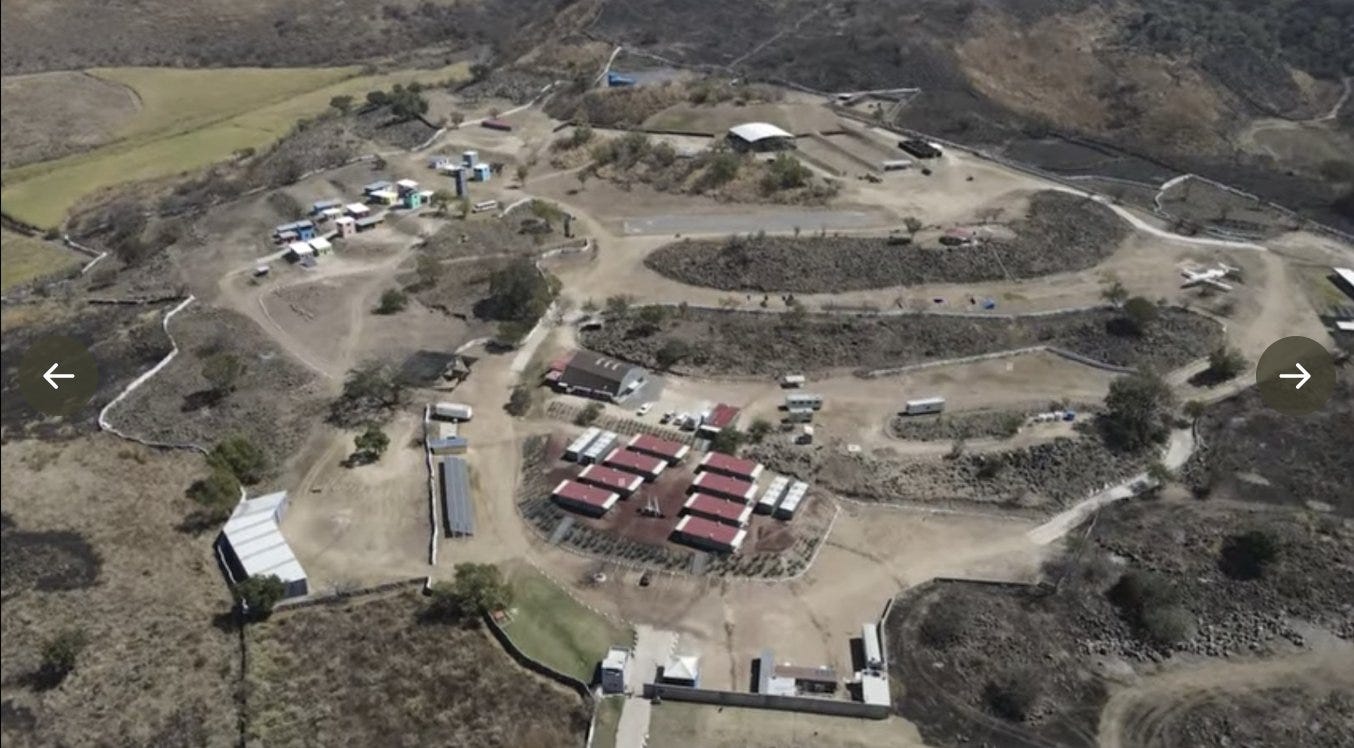Mexican Cartels: How the World's Most Powerful Crime Groups Became Militarized Units
With advanced weapons and tactics at their disposal, Mexican cartels are more militarized ever before. However, a military response still may not be the best bet at combating them.
The Cartel Jalisco Nueva Generacion (CJNG) routinely outfits their operatives with high-grade weapons, armor, and uniforms. Source
In the early hours of January 5, 2023, 32-year-old Ovidio Guzman Lopez slept in his home with his wife, mother, and three daughters following a party there the day before. The family arrived at the luxurious compound in December to celebrate Christmas and likely chose it due to its defensible location. The residence, located on a hilltop with sweeping vistas, sits some 40 minutes outside Culiacan, the capital of the Mexican state of Sinaloa. Guzman had ample reason to be suspicious: a significant figure in the Sinaloa cartel and a suspected overseer of its fentanyl production and trafficking operations, the U.S. government placed a bounty of over $5 million on his head. The youngest son of infamous former Sinaloa boss Joachim “El Chapo” Guzman, the younger Guzman was also a high-profile target for Mexican authorities.
Then came mayhem. The Mexican military dispatched planes and helicopters and hundreds of soldiers precisely to capture Guzman, approaching by land and air and spraying the compound with bullets without notice. For over ten hours, the Mexican military engaged in a firefight with Guzman’s henchmen. Bullets eviscerated the front door and destroyed much of the main hall, leaving a scene of broken glass and blood-stained furniture. Soldiers then apprehended a fleeing Guzman – who had an anti-aircraft gun and 46 other weapons in his bedroom alone – as he attempted to reach a secret tunnel located at the back of the property.
Authorities airlifted Guzman to a maximum security in Mexico City just as further carnage got underway. At the airport, cartel gunmen clashed with security forces on the tarmac, grounding planes as passengers ducked inside them: this was apparently to prevent military aircraft from taking off and landing. Similar to the unsuccessful attempt to arrest Guzman and the battle that ensued in 2019, the Sinaloa Cartel employed advanced weapons and military tactics to combat the Mexican armed forces. These measures included a convoy of 25 vehicles mounted with military-grade 50 caliber machine guns that prompted the army to call in Blackhawk helicopters. It was only after nine days of heavy fighting that the Sinaloa cartel withdrew its force of some 5,000 militants. The clashes killed 29 people, including ten soldiers.
This incident, and others like it, demonstrate the growing militancy of Mexico’s multibillion-dollar drug cartels. With Mexican authorities now increasingly treating these organizations as a military rather than a law enforcement matter and many U.S. politicians talking of doing the same, the stage is being set for an all-out confrontation with groups armed with advanced weaponry and skilled in battlefield tactics.
Burning vehicles in Culiacan in January 2023. The operation to arrest Ovidio Guzman Lopez resulted in nine days of intense battles across Sinaloa. Source
Weaponry and tactics
In July 2020, the Cartel Jalisco Nuevo Gènèracion (CJNG) released a propaganda video showing dozens of men standing next to armored trucks, dressed in uniforms and body armor, and carrying military-grade weapons. In the video, CJNG operatives used grenade launchers, assault rifles, holographic weapon sights, night vision goggles, and bulletproof vests. A joint investigation by the U.S. Federal Bureau of Investigation (FBI) and Drug Enforcement Agency (DEA) concluded that these were primarily sourced from eBay. The Mexican army regularly captures weapons such as belt-fed machine guns, rocket launchers, and grenades from cartel militants – weapons not sold for civilian use in the United States. These seizures prompted Mexican authorities to warn their U.S. counterparts about the cross-border transfer of military-grade weapons and call for an investigation this January.
In addition to advanced weapons, Mexican cartels regularly recruit highly trained military professionals into their ranks. In 2019, one witness routinely described seeing deserters from the Mexican and U.S. militaries at CJNG Sicario (hitmen) training camps. “The high command bought marines from an elite group,” the witness said, further claiming that former members of the U.S. Navy Seals and Delta Force were present in these training camps. Mexican authorities identified 23 sites containing CJNG militant operatives between 2013 and 2018, with at least four of these used for training purposes. Found across the country from the U.S. to the Guatemalan borders, each site contained between 50 and 60 CJNG members overseeing up to 40 captive recruits.
The steady outflow of Mexican military personnel began in the 1990s when ex-special forces created the Zetas cartel – a group known to employ military techniques such as ambushes, the establishment of defensive positions, and small-unit tactics. Mexico’s Ministry of Defense estimates that 1,383 elite soldiers deserted between 1994 and 2015, and a 2005 FBI intelligence document claims that many of these received training in counterterrorism, counterintelligence, interrogation, and strategy from French, U.S., and Israeli military advisors. Estimates claim these cartels employ up to 185,000 people from all walks of life and draw in hundreds of recruits each week.
An aerial shot of a reputed CJNG training camp near Guadalajara. Source
A military approach to a militant threat
The rising militancy of Mexican cartels is attributable to three factors. First is the country’s war on drugs, which started in 2006 and increasingly relies on the country’s military to combat these groups as opposed to law enforcement. This military approach required that Mexican cartels – whose ranks already contained ex-servicemembers – evolve tactically to survive and thrive in an environment that forced them to contend with military power.
Although current Mexican president Andres Manuel Lopez Obrador (AMLO) ran his 2018 campaign under the slogan abrazos, no balazos (hugs, not bullets) regarding the military campaign against the cartels, this did pertain to military expansion. Instead, the president allied closely with his country’s top brass, creating a new militarized force called the National Guard and placing it under military supervision. Now, the presence of Mexico’s military is ubiquitous across the country, where they are tasked with running major airports and other civilian infrastructure while being dispatched to missions such as tracking down missing migrants or fighting crime in Tijuana. As 2022 data leaks show, Mexico’s military is not above corruption, with numerous examples of payoffs and collusion with the cartels. In this way, Mexico’s ongoing military expansion may benefit cartel operations. It may also explain where the cartels obtain some of their military-grade weapons.
Another factor is the intense competition that exists between Mexico’s cartels, who regularly vie for control over plazas – smuggling staging through which narcotics and other illicit goods flow both internally and across borders. These turf wars became increasingly militarized in the 2000s when the Zetas – a group founded by ex-Mexican special forces – broke off from the Gulf Cartel and began using military tactics in their fight against them. Although the Zetas are a fragmented organization today, their militant legacy lives on through the CJNG, who modeled their tactics on the Zetas and whose intense rivalry with the Sinaloa cartel necessitates the increased militarization of both groups.
Money is the third factor. Estimates on the total revenue Mexican cartels bring in each year vary so significantly that it is impossible to find a reliable figure. Still, one recent estimate claims that migrant smuggling alone generates $13 billion annually, while foreign remittances could generate as much as $4.4 billion annually. Given that neither of these figures includes the full value of their main business—narcotics trafficking—one gets a sense of how much money these groups have at their disposal.
Mexican cartels originated by growing and trafficking opium and marijuana into the United States, but it was their foray into cocaine distribution that brought them into global prominence. Now, these groups stand at the forefront of the deadliest drug epidemic in American history by trafficking fentanyl sourced from China into the United States. The money and power generated by this trade allow these groups to infiltrate and bend civilian and military institutions in their favor. This reach often reaches the very top, with ProPublica recently publishing a report that millions of dollars of cartel money reached some of AMLO’s top aides in the 2000s. Moreover, on February 21, a Brooklyn jury convicted Genaro Garcia Luna – Mexico’s top law enforcement official between 2006 and 2012 – of accepting millions of dollars in cash bribes from the Sinaloa Cartel in exchange for favors. With influence approaching the very top of the Mexican political system, it becomes apparent how Mexican cartels became a highly militarized threat to the state over time.
Once Mexico’s top law enforcement official, Genaro Garcia Luna (right) was on a payroll of the Sinaloa Cartel for years. He was convicted by a Brooklyn Court this January. Source
A supply-based solution to a demand-driven problem
A growing number of Republican politicians and lawmakers – including Presidential hopeful Donald Trump – call for the use of military force against Mexican cartels. However, with Mexico’s military engaged in a war on these cartels for nearly two decades, it seems a military response has only exacerbated the problem. A recent article by Shannon O’Neil notes that Mexico’s military response and increasingly tough rhetoric out of Washington continue to hinder cross-border cooperation between law enforcement agencies, which are the best equipped to deal with criminal groups. Writing for Small War Journal last March, Michael Burgoyne and Albert Marckwardt note that military approaches have done little to curb drug usage in the United States, which is the primary driver of the illicit drug trade, and that health-based approaches have been more effective in this regard. In an article I wrote for Militant Wire last year, I also noted that targeting demand rather than supply may produce more fruitful results than military operations, citing a 2005 study by the RAND Corporation.
Conclusion
With Mexico’s cartels now better equipped, tactically capable, and politically influential than ever before, how leaders respond to this threat is of critical importance. Should fire continue to be fought with fire, it is conceivable that this threat will only strengthen moving forward.







Rarely does anyone talk about the REAL problem- the addicts and consumers. Mexico doesn't have a drug problem, the US does. All the consumers are in the US. Mexico suffers theviolence of the demand created by US drug users. The "war on drugs" has never worked. Demand is always supplied, by whatever means necessary. Unless the root issue is addressed, American drug use, nothing will change.
It seems that some special operators from various countries have become nothing more than highly paid criminals. It’s a damed shame . With that said I do not want to see the US military involved in Mexico. It would be a disaster. If Mexico needs weapons, training or intelligence I’d be okay with that. Mexico is capable of fighting this themselves and they don’t want the US there. Just as in the US corruption is the biggest obstacle to law and order. The old saying still stands, it’s good for thee, but not for me. I retired to Mexico and feel safer here than Kansas City, but I don’t go looking for trouble either. If there was no demand there would be no drug cartels. Control our borders and most of the problem would be solved.